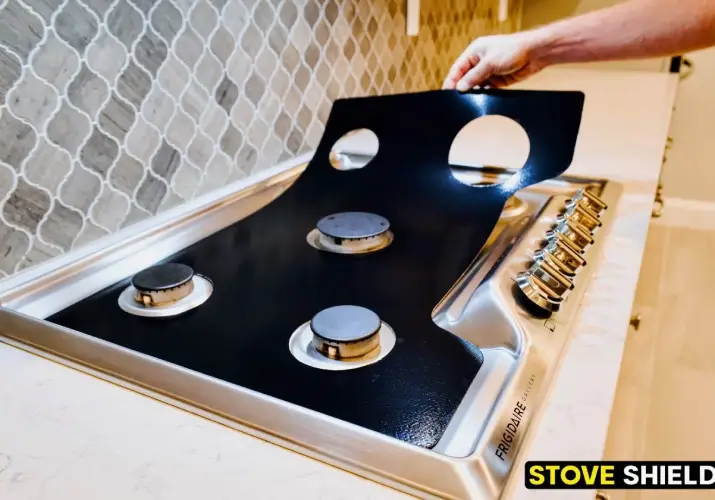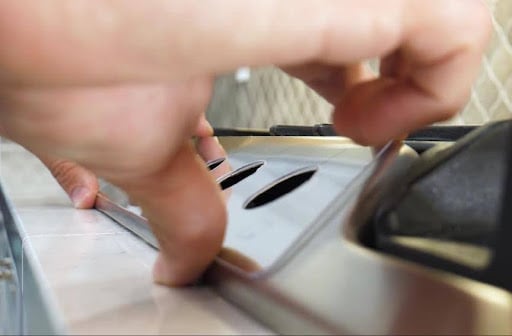Noodle boards—also known as stovetop covers—have become a trendy addition to modern kitchens. Typically made of wood, these covers are designed to sit over the gas burners when the stove is not in use, offering extra counter space, a rustic aesthetic, and a clever way to keep your cooktop clean. Many homeowners use them for meal prep, serving, or simply to add charm to their kitchen decor.
As their popularity continues to rise, especially among those looking to maximize functionality in small spaces, a growing number of gas stove owners are asking an important safety question: Is it safe to use a noodle board on a gas stove?
Let’s explore the facts behind noodle boards and gas stove safety so you can make an informed decision for your kitchen.
What Is a Noodle Board?
A noodle board is a large, flat board designed to cover the surface of a stove top when it’s not in use. Also known as a stovetop cover or stove top board, it serves decorative and functional purposes in the kitchen.
Traditionally, noodle boards were used as a surface for rolling out dough—hence the name. Over time, their use evolved, and today they’re often placed over stove burners to provide extra counter space, hide unsightly cooktops, or enhance the kitchen’s visual appeal.
Most noodle boards are made of wood (acacia wood), giving them a warm, rustic charm. However, some modern versions use metal or composite materials for added durability or style. While their design may vary, their core purpose remains the same: to blend utility with aesthetics in the heart of the home.
Why Do People Use Noodle Boards as a Stove Top Cover on a Cooktop?
Noodle boards have become a favorite kitchen accessory for several practical and aesthetic reasons:
- Extra Prep or Counter Space: Especially in small kitchens, a noodle board or a wood cutting board offers valuable additional workspace for chopping, mixing, or staging ingredients when the stove isn’t in use.
- Conceals the Stove: A noodle board for gas stovetop helps keep the kitchen looking tidy by covering burners and creating a uniform surface, ideal for entertaining or maintaining a clean, uncluttered look.
- Decorative Appeal: With designs ranging from rustic farmhouse to personalized engravings, noodle boards serve as a stylish centerpiece that enhances the kitchen’s character and theme.
- Stove Protection: When the gas range isn’t in use, a wood noodle board (when used as a wood stove top cover) acts as a barrier against dust, scratches, and spills, helping preserve the stove’s condition over time.
This blend of form and function is what makes noodle boards so popular, but when it comes to gas stoves, safety considerations are essential.
How Gas Burner Stoves Work (and Why It Matters)
To understand the safety concerns of using an acacia wood noodle board on a gas stove, it’s important to know how gas stoves operate.
- Open Flame Mechanism: Gas stoves work by igniting natural gas or propane through a burner. This creates an open flame that heats your cookware. Unlike electric stoves, which cool down gradually, gas stoves involve real combustion and immediate fire exposure.
- Residual Heat: Even after the burners are turned off, the grates and top of the stove can remain hot for several minutes. Placing a flammable object like a wooden noodle board over a still-warm stove poses a serious fire hazard.
- Gas Leaks and Ignition Risks: If a burner is accidentally left slightly open or if there’s a slow gas leak, covering the stove with a noodle board can trap the gas. The moment an ignition source appears—or even static discharge—it can ignite the accumulated gas, leading to fire or explosion.
- Ventilation and Airflow: Proper airflow is essential around a gas stove. Blocking the stove with a board limits ventilation and can increase the risk of overheating or gas accumulation, particularly in poorly ventilated kitchens.
These factors make safety a top concern when deciding whether to use a noodle board stove cover on a gas stove.
Risks of Using a Noodle Board Stove Cover on a Gas Stovetop
While noodle boards offer convenience and charm, using them on a gas stove comes with serious safety risks:
- Fire Hazard: Most noodle boards that cover your stove are made of wood, a naturally flammable material. Even if the burners are off, residual heat or a pilot light can ignite the board, especially if it’s placed on a recently used stove.
- Gas Buildup: One of the most dangerous risks is accidental gas release. If a burner is unintentionally turned on beneath a covered stove, gas can build up under the noodle board. This creates a high risk of explosion or flash fire when the gas eventually ignites.
- Residual Heat Ignition: Many gas stoves retain heat long after being turned off. A hot grate or lingering pilot light can cause the wood to scorch or catch fire if the noodle board is placed too soon.
- Ventilation Blockage: Noodle boards completely cover the cooktop, restricting airflow and ventilation. This can lead to overheating or gas accumulation, particularly in kitchens with limited ventilation systems.
Because of these risks, using a traditional wooden noodle board on a gas stove—especially while the stove is still warm or in use—is not considered safe without taking specific precautions.
Situations Where It Could Be Especially Dangerous
Certain home environments increase the risk associated with using a noodle board on a gas stove, making caution even more critical:
- Homes with Children or Pets: Curious kids or pets can accidentally bump stove knobs, turning on a burner beneath the board. If unnoticed, this can lead to a dangerous gas buildup or even a fire.
- Older Gas Stoves with Standing Pilot Lights: Some older gas stoves have a constantly burning pilot light. Placing a flammable noodle board over such a stove introduces a continuous fire risk, even when the burners are off.
- Poorly Ventilated Kitchens: Limited airflow in tight kitchen spaces can prevent gas from dispersing if there’s a leak. A noodle board covering the stove traps any leaked gas, increasing the risk of combustion.
- Forgetfulness or Distraction: In busy households, it’s easy to turn on a burner without realizing the board is still in place. This simple mistake can quickly escalate into a fire or gas emergency.
In these situations, using a noodle board without clear safety measures can turn a decorative item into a serious hazard.
Best Practices if You Still Want to Use a Noodle Board Stovetop Cover on a Stove Top
If you love the look and utility of a noodle board and still want to use one with your gas stove, it’s crucial to follow strict safety guidelines to reduce risk:
- Only Use When the Stove Is Completely Cool: Always ensure the burners, grates, and surrounding surface are fully cool before placing the board on the stove. Even low residual heat can pose a fire hazard with wooden materials.
- Never Leave It on During Stove Use: A noodle board should never be on the stove while it’s operating. Remove it entirely before turning on any burners—even for a quick use.
- Remove Immediately After Cooking: Once cooking is done, give your stove time to cool, then remove the noodle board before it becomes part of your regular routine again.
- Use Burner Knob Covers: Installing childproof burner knob covers can help prevent accidental ignition, especially in households with kids or pets.
- Choose Fire-Retardant Materials: If possible, select a noodle board that has been treated with fire-retardant coatings. Keep in mind that these coatings can slow combustion but do not make the board completely fireproof.
- Inspect Your Stove Regularly: Periodically check gas lines, burner valves, and pilot lights for leaks or malfunction. Safe stove operation is your first line of defense against kitchen fires.
By following these best practices, you can enjoy the decorative and functional benefits of a noodle board—with added caution and responsibility.
Alternatives to Noodle Boards for Gas Stoves
If safety is a top priority—but you still want to enhance your stove’s appearance and functionality—there are safer alternatives to traditional wooden noodle boards:
- Metal Stove Covers: Made from stainless steel or other non-combustible materials, metal covers provide a sleek look and added surface space without the same fire risk. They’re also easy to clean and highly durable.
- Tempered Glass Covers: Heat-resistant and stylish, tempered glass covers can serve both protective and decorative purposes. They’re especially useful for shielding the cooktop from dust and spills while maintaining a modern aesthetic.
- Burner Liners and Stove Shields: Products like stove shields or custom-fit burner liners offer excellent surface protection and visual appeal without covering the entire stove. They allow for safe airflow, reduce the risk of fire, and still keep your kitchen looking neat and tidy.
These alternatives offer a safer way to protect and beautify your gas stove—without compromising on function or style.
How StoveShield Offers a Safer Alternative
At StoveShield, safety and functionality go hand in hand. Unlike traditional wooden noodle boards, StoveShield products are specifically designed for use with gas stoves, offering a safer, more practical solution for protecting and enhancing your cooktop.
- Custom-Fit Protection: StoveShield burner covers and stove shields are tailored to fit your specific stove model, providing targeted protection without covering the burners entirely. This ensures safety while keeping your stove clean and looking sharp.
- Heat-Resistant, BPA-Free Materials: Made from high-quality, heat-resistant materials that are free from BPA and other harmful chemicals, StoveShield products are built to withstand the heat of everyday cooking without warping, melting, or posing a fire risk.
- Gas Stove-Safe Design: Every StoveShield product is engineered with proper ventilation and burner access in mind, ensuring it functions well as a stove top cover for gas stoves. You can cook with confidence, knowing airflow isn’t restricted and gas isn’t being trapped beneath a stove top cover.
- No Risk of Fire or Gas Blockage: With StoveShield, there’s no need to remove a large board or worry about accidental ignition. Our products allow for everyday use without the risks associated with flammable materials.
If you’re looking for a stylish yet safe way to protect your gas stove, StoveShield is the smarter, safer choice—designed to give you peace of mind without sacrificing kitchen convenience.
Conclusion
Using a traditional wooden noodle board on a gas stove carries significant risks, including fire hazards, gas buildup, residual heat ignition, and blocked ventilation. These dangers are amplified in homes with children, older stoves, or poor kitchen ventilation, making caution essential.
Because of these safety concerns, we strongly recommend avoiding the use of noodle boards on gas stoves—or at the very least, following strict safety practices if you do choose to use one.
For a safer, more practical way to protect and style your gas stove, consider StoveShield. Our custom-fit, heat-resistant stove shields provide protection without covering burners or blocking airflow, eliminating the risks associated with traditional stove covers while enhancing your kitchen’s look and functionality. Safety and style don’t have to be mutually exclusive—StoveShield delivers both.
Disclaimer: All information contained within this article is for informational purposes. always refer to your specific stove manual for safety and use instructions and guidance.


